
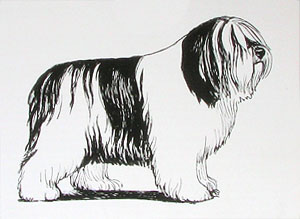
The Czech title: Polský ovčák nížinný
The original title: Polski Owczarek Nizinny
The English title: Polish Lowland Sheepdog
The abbreviation: Czech: PON, English: PLS
The number of standard FCI: 251
Group FCI: Group 1 – Sheepdogs and Cattle Dogs (except Swiss Cattle Dogs)
 The Polish Lowland Sheepdog and its origin
The Polish Lowland Sheepdog and its origin
A breed that is popular with residents in the plains of Poland is an important link between the ancient Asian herding dogs with corded fur, who came to Europe thousands of years ago, and younger fluffy shepherds, such as the Scottish Bearded Collie or Dutch shepherd poodle. The breed was recovered by Polish breeders after the Second World War. In Poland and neighboring countries, the Polish Lowland Sheepdog acts as a home companion but still retains the characteristics of an excellent guard dog.
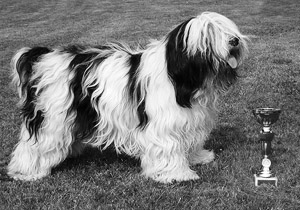 The description of the Polish lowland sheepdog
The description of the Polish lowland sheepdog
The Polish Lowland Sheepdog is a medium sized and slightly podgy dog with thick, long hair. Its trunk has a rectangular shape with well-arched chest, muscular back and deep loins. Its legs are strong and paws oval. Its withers measure from 45 to 50 cm, a female from 42 to 47 centimeters. It weighs up to 20 kg. The head is medium sized with a pronounced stop and a large blunt nose. Medium sized brown eyes with a lively expression. Its ears are heart-shaped, hanging close to cheeks. Its teeth are strong and it has scissors bite. The Polish Lowland Sheepdog stands out mainly because of its beautiful and rich hair which covers the entire body and creates a typical fringe over the eyes. It can be slightly wavy and have a thick undercoat. Its coloring can have any characters.
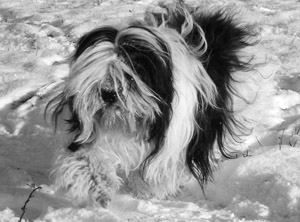 Characteristics and traits of The Polish lowland sheepdog
Characteristics and traits of The Polish lowland sheepdog
The Polish Lowland Sheepdog is very hardy, spirited, independent, dominant, very vigilant, courageous and sociable. It has an open, balanced character, but it can’t deny its origins and is an excellent defender - it properly warns against a newcomer and may be suspicious of strangers. It is quick to learn and obedient after a good training. It can easily get used to humans and other animals, it loves children. It is tied to its family and master. It is curious, playful, loves walks and is suitable for nature lovers. It has a great sense of smell.
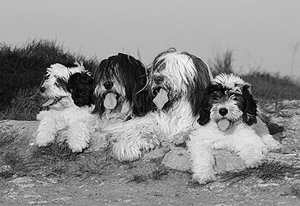 The education of The Polish lowland sheepdog
The education of The Polish lowland sheepdog
The Polish Lowland Sheepdog as a puppy is curious, playful and very lively. But from my own experience I can say that it does not destroy or gnaw a household. I recommend early socialization, meaning to expose it to other foreign environment, people and animals. Walk it around town, take it to restaurants, parks, or to any events where there are a lot of people and dogs. Without this education, having innate distrust this breed can grow into being fearful or even aggressive. I emphasize this because it often happens that dog owners believe everything a dog needs is just to run around a large garden. Teaching this dog at least the basic commands is a matter of course.
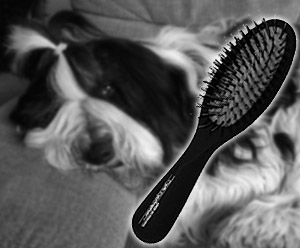 The basic care of the Polish lowland sheepdog
The basic care of the Polish lowland sheepdog
The Polish Lowland Sheepdog requires a care only in terms of hair. It is very dense and should be brushed and always kept clean. I am often asked whether I have to brush it every day or whether I have got a lot of hair around my household. My answer is that there is less than from a German Shepherd or a Labrador for example. The PLS has long hair which falls out very rarely on its own. It doesn't fall out even after it dies out. And it creates dreadlocks if it isn't brushed out. Regular brushing also removes dead hair. That's why there is less hair in the household when living with a longhair dog than there is living with a shorthair dog. Important is regular brushing and bathing when it is needed. I often practice so-called cleansing chassis - this means showering legs and abdomen. Adult dogs are brushed 1x to 2x a week. Using a water spray I spray the dog with nutrients before I brush it. This takes no more than half an hour. Puppies and young dogs require more frequent brushing until they get rid of the soft undercoat. Given that the PLS has long ears, their condition must be monitored and the inside hair regularly removed.
 Nutrition
Nutrition
In typical urban conditions, the PLS needs less food than the other dogs of similar size. However, they have a huge appetite and often suffer from being overweight. They are not picky, they love meat, vegetables, fruit even dry bead.
© Corallium, Broňa Rýparová, Czech Republic, tel. +420 602589471


